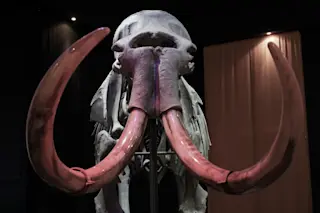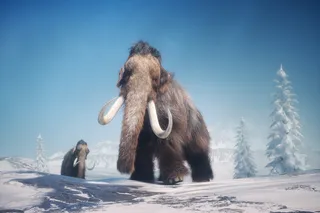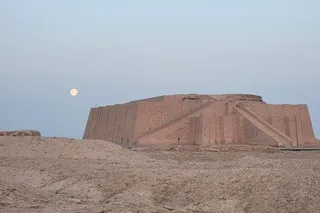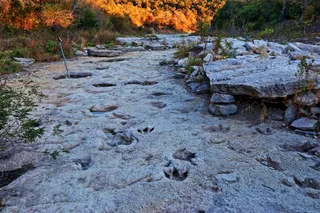Fossils of prehistoric elephants may have inspired the Greek myth of giant, one-eyed, man-eating creatures, known as cyclopes. In the Odyssey, the ancient Greek poet Homer recounts the hero Odysseus’s near fatal encounter with the cyclops Polyphemus. Stranded with his crew on the island of Sicily, the wily Odysseus blinds the giant and escapes with the remnants of his crew — many of whom had been eaten — beneath a herd of sheep.
It’s possible that visitors to islands in the Mediterranean stumbled across the skulls of ancient elephants in caves with bones scattered around them, conjuring up stories of gigantic, one-eyed, man-eating beasts.
“Anyone who goes to a natural history museum and looks at the skull of an elephant can see that the eye sockets are negligible, you don't even notice those,” says Adrienne Mayor, a research scholar in the Classics Department at Stanford University who has studied fossils and ancient myths extensively. “What you notice is the gigantic hole in the middle of the skull that looks like a single eye.”
Did Mammoth Skulls Spur the Myth of the Cyclops?
That hole is, of course, a nasal cavity. But prior to the time of Alexander the Great, in the mid-fourth century B.C.E., ancient Greeks would never have seen a live elephant, and thus could easily have mistaken it for a large, singular eye socket.
Read More: Where Woolly Mammoths Roamed, Humans Trailed Close Behind
Fossils of numerous prehistoric beasts are known from Mediterranean islands, such as Crete, Malta, and Cyprus, including species of dwarf elephants on the island of Sicily, the home of Polyphemus.
Bones of mammoths, mastodons, and other extinct elephants could thus have some part in the development of the cyclops legend. In the case of the island of Samos, megafauna fossils might have been linked to the legend of the Neades, gigantic beasts said to screech so loudly they could cause earthquakes.
Though it’s a distinct possibility that such fossils were wrapped up in ancient myth making, there's no evidence to confirm whether the remains of these animals predated the myths themselves — it could also be that these myths already existed, and the fossil discoveries simply confirmed them, Mayor notes.
“We don’t know which comes first,” she says. “I don’t like to say that the fossils inspired, or were the source of the story, because we just can’t prove that.”
Did Ancient Greeks and Romans Encounter Fossils?
In antiquity, such discoveries of fossils from long-extinct creatures may well have confirmed preexisting ancient beliefs about giants and other mythical creatures, such as the griffin. This composite creature — part bird, lion or eagle — is said to have guarded its nest fiercely and attacked those seeking to harvest gold in Central Asian deserts.
According to research by Mayor, well-preserved fossils of the beaked dinosaur protoceratops may have influenced depictions of the griffin, which later found its way into Greek myth.
Read More: Are Dragons Real? The Unique History and Origins of Mythical Dragons
“The ancient Greeks believed that their heroes of myth — like Achilles, Ajax, Odysseus — were all about three times the size of puny, present-day men and women,” Mayor says. “When they found a large femur or thigh bone that actually belonged to a prehistoric elephant, it looked just like a human shoulder blade or thigh bone, only three times the size.”
In research conducted for her work First Fossil Hunters: Dinosaurs, Mammoths, and myths in ancient Greek and Roman times, Mayor matched ancient literary evidence of fossil finds with actual paleontological dig sites and found a strong correlation. Alongside examples of large fossil bones found in archaeological sites such as temples, this provided evidence that ancient peoples “took notice of, attempted to explain and even collected, measured, and displayed gigantic fossils”, in her view.
Did Fossils Influence Ancient Greeks and Romans Myths?
“I think there’s no doubt that fossils influenced the way the ancient Greeks and Romans pictured mythological stories about giants, monsters, and fabulous creatures,” Mayor says.
She also notes that this practice of interacting with fossils and developing stories from them — such as one-eyed Polyphemus and his fateful encounter with Odysseus — extends through history to other cultures and indigenous peoples.
“People in antiquity and in prescientific cultures worked hard to explain and to account for these mysterious remains in their lands,” Mayor says. “I think they used a combination of rationality and imagination – in the same way that paleontologists do when trying to bring to life the remains of an unfamiliar creature that they will never see alive – and tried to imagine its appearance, its behavior, and its habitat.”
Read More: Mythical Creatures: The Lore and Legends Behind 3 Medieval Monsters
Article Sources
Our writers at Discovermagazine.com use peer-reviewed studies and high quality sources for our articles, and our editors review for accuracy, and trustworthiness. Review the sources used below for this article:
Worldhistory.org. Homer.
Worldhistory.org. Odysseus.
Geological Society, London, Special Publications. Giants and elephants of Sicily.
Britannica. Alexander the Great.
Italian journal of anatomy and embryology. Cyclopia: from Greek antiquity to medical genetics.
50 Current Biology. Estimating the dwarfing rate of an extinct Sicilian elephant.
Earth Sciences History. Ancient References to the Fossils From the Land of Pythagoras.
Britannica. Griffin.
American Museum of Natural History. Griffin Bones.
Natural History Museum. Protoceratops.
Stanford School of Humanities and Science. The First Fossil Hunters: Dinosaurs, Mammoths, and Myth in Greek and Roman Times
Read More: Are Sea Monsters Real? The Truth Behind These Famous Sea Legends















